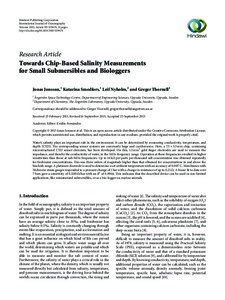Towards Chip-Based Salinity Measurements for Small Submersibles and Biologgers.

View/
Average rating
votes
Date
2013Author
Jonsson, Jonas
Smedfors, Katarina
Nyholm, Leif
Thornell, Greger
Metadata
Show full item recordAbstract
Water’s salinity plays an important role in the environment. It can be determined by measuring conductivity, temperature, and
depth (CTD). The corresponding sensor systems are commonly large and cumbersome. Here, a 7.5 × 3.5 mm chip, containing
microstructured CTD sensor elements, has been developed. On this, 1.5 mm2 gold finger electrodes are used to measure the
impedance, and thereby the conductivity of water, in the MHz frequency range. Operation at these frequencies resulted in higher
sensitivities than those at sub-MHz frequencies. Up to 14 kΩ per parts per thousand salt concentration was obtained repeatedly
for freshwater concentrations. This was three orders of magnitude higher than that obtained for concentrations in and above the
brackish range. A platinum electrode is used to determine a set ambient temperature with an accuracy of 0.005∘
C. Membranes with Nichrome strain gauges responded to a pressure change of 1 bar with a change in resistance of up to 0.21 Ω. A linea.....
Journal
International Journal of OceanographyVolume
2013Page Range
Article 529674 [11pp.]Document Language
enEssential Ocean Variables (EOV)
Sea surface salinitySubsurface salinity
Maturity Level
TRL 4 Component/subsystem validation in laboratory environmentBest Practice Type
GuideDOI Original
https://doi.org/10.1155/2013/529674Citation
Jonsson, J,; Smedfors, K.; Nyholm, L. and Thornell, G. (2013) Towards Chip-Based Salinity Measurements for Small Submersibles and Biologgers. International Journal of Oceanography, 2013, Article 529674 [11pp.] DOI: https://doi.org/10.1155/2013/529674.Collections
The following license files are associated with this item:
 Repository of community practices in Ocean Research, Applications and Data/Information Management
Repository of community practices in Ocean Research, Applications and Data/Information Management
